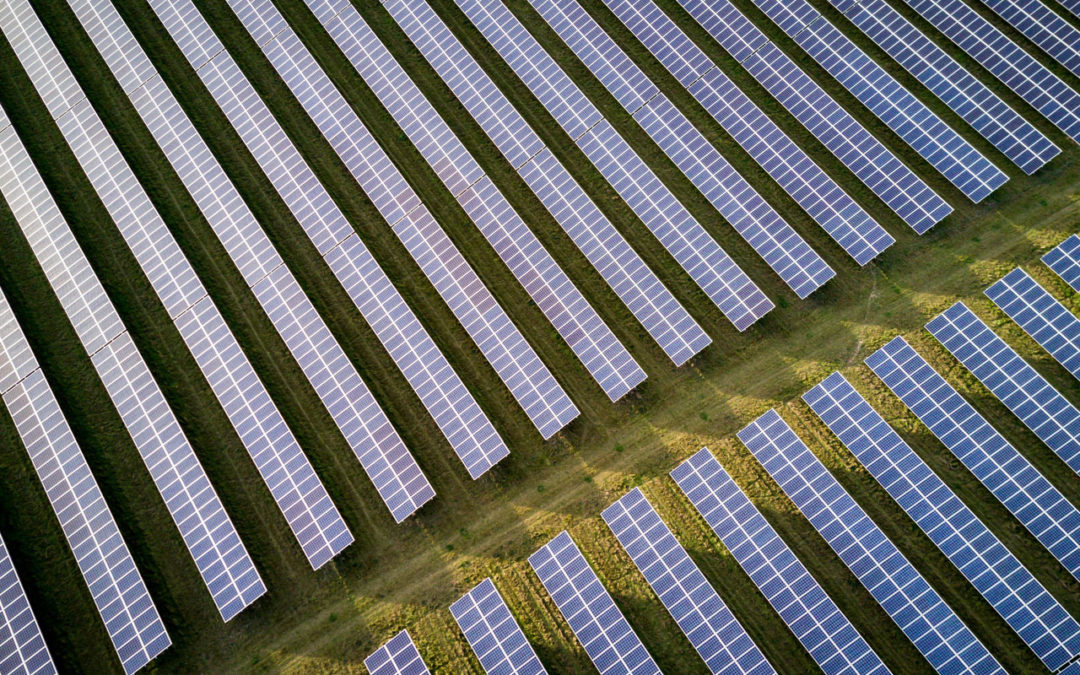
by Lauren Reeg | Feb 17, 2021 | Energy Storage, Renewables, Solar, Utility Scale
3.11.2021 Update: After the initial posting of this blog, further research indicates that the Darien Solar Energy Center would have a *capacity factor likely closer to 0.24, not .30. Using this updated capacity factor of .24 for the Darien Solar Energy Center, emissions would decrease by 423,000 tons of carbon dioxide (CO2), 602,000 pounds of nitrogen oxides (NOx), 745,000 pounds of sulfur dioxide (SO2), and 76,000 pounds of particulate matter (PM10) annually for the lifetime of the project. These emissions reductions would lead to decreased mortality of about one life per year, annual health savings between $15 to $34 million, and yearly climate savings of over $17 million
* Capacity factor expresses in percentage form the expected production of a power plant relative to its maximum possible output. This ratio takes into account variables such as maintenance-related downtime and the availability of the energy source fueling the plant. All power plants have a capacity factor of less than one.
Consider a solar farm sized to produce a theoretical maximum of 10,000 megawatt-hours/year. If the plant is estimated to have a capacity factor of 0.30, it can be expected to produce 3,000 megawatt-hours a year. A solar farm could not have a 1.0 capacity factor because the sun doesn’t shine all day. In fact, with nighttime constituting half of the hours in a year, a solar farm could not have a capacity factor greater than 0.50.
The Darien Solar Energy Center is a proposed 250-MW solar PV facility in Walworth county, Wisconsin currently under review at the Wisconsin Public Service Commission. If approved, developers hope to have the project constructed and energized by 2023, offering significant health, environmental, and economic benefits to local Wisconsin communities.
Using the EPA’s Avoided Emission and Generation tool, RENEW Wisconsin estimates that the Darien Solar Energy Center could reduce emissions by 538 thousand tons of carbon dioxide (CO2), 700 thousand pounds of nitrogen oxides (NOx), 1 million pounds of sulfur dioxide (SO2), and 98 thousand pounds of particulate matter (PM10) annually for the lifetime of the project. Carbon dioxide is a greenhouse gas that contributes to climate change, and sulfur dioxide, nitrogen oxides, and particulate matter contribute to health problems including asthma, cardiopulmonary disease, and premature mortality. Fossil fuel power plants are the primary emission sources of these pollutants. Transitioning to the clean energy produced by the Darien solar project, Wisconsin would reduce its fossil fuel generation, providing significant human health and environmental benefits to its residents.
RENEW Wisconsin completed in-house research on the health benefits of the Darien project. Using the EPA’s Co-Benefit Risk Assessment model, the Darien Solar Energy Center is estimated to reduce mortality by up to one life per year for 30 years in Wisconsin. The health impacts are substantial for Wisconsin, a state highly dependent on coal-fired electricity generation. Energizing the Darien Solar Energy Center could directly save Wisconsin lives.
In addition to the health benefits of clean energy, there are also significant economic benefits this solar project could deliver. Using the EPA’s health benefit factors for Wisconsin, the annual savings ranged from $18 to $42 million depending on population, pollution burden, and other differentiating factors. Moreover, Darien could produce up to $22 million in annual savings resulting from avoided climate impacts. Climate impacts are estimated from the EPA’s social cost of carbon values. These monetized health impacts are significant and illustrate the benefits that the Darien Solar Energy Center could bring to the Wisconsin economy.
Overall, these findings detail the benefits that the Darien Solar Energy Center offers Wisconsin by reducing pollution, decreasing human mortality, helping to mitigate climate damages, and providing millions of dollars in economic benefits to the state. Other significant benefits related to Wisconsin GDP, employment, and environmental and water impacts were not discussed in this article. To learn more about the Darien Solar Energy Center and its additional benefits, please visit the Town of Darien website.
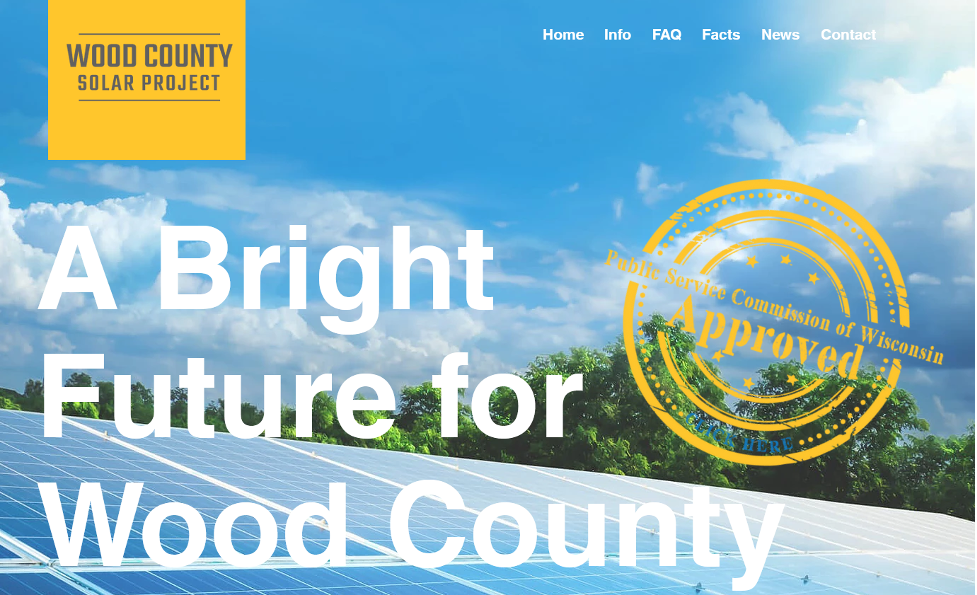
by Michael Vickerman | Jan 26, 2021 | Public Service Commission, Solar, Utility Scale
At its first open meeting of 2021, the Public Service Commission (PSC) cleared the path for Wisconsin’s next solar farm, a 150 megawatt (MW) project near Wisconsin Rapids in Wood County, to proceed to construction. Developed by Savion Energy, the Wood County Solar Farm is one of six Wisconsin solar farms totaling 675 MW that Alliant Energy-Wisconsin Power and Light seeks to acquire for its own generating fleet.
Wood County is the sixth solar farm proposal to be granted a siting permit from the PSC since April 2019, when the agency approved Wisconsin’s first two solar farms, Two Creeks and Badger Hollow. With the authorization of the Wood County project, total solar power capacity approved by the PSC climbed above one gigawatt (see Table 1).
With this favorable ruling, four of the six solar farms that Alliant Energy plans to acquire now have permits. In addition to Wood County, the other permitted solar farms are Crawfish River, a 75 MW project near Jefferson, North Rock, a 50 MW project near Edgerton, and Richland County Solar, a 50 MW project near Lone Rock, also developed by Savion Energy (see Table 2).
Two other proposed solar farms—the 200 MW Grant County project near Potosi and the 150 MW Onion River project near Oostburg in Sheboygan County–are moving through the regulatory review process. The PSC is expected to issue rulings on those two projects, along with Alliant’s application to own and operate all six solar farms, over the next three months.
Presently, the site is mostly a red pine plantation grown for the pulp and paper industry. Following PSCW approval of Wood County Solar Project, the work to harvest the site’s existing stand of trees will begin. Coordination has already commenced between the Project, Alliant Energy, The Town of Saratoga, and Wood County to ensure an orderly harvesting campaign.
Though the parcel has been a working tree farm since 1938, development pressure has been intensifying in recent years. In 2012, the Wysocki Family of Companies applied for permits to establish a 3,500-cow dairy operation on that property, and over time the proposal grew to approximately 5,300 cows. The residents of the Town of Saratoga fought the dairy proposal vehemently, in part to protect drinking water wells that supply many of the local families. The solar farm has received wide support in the community.
The construction timetable calls for the completion of the solar farm in the fourth quarter of 2022.
| Table 1: PSC-approved solar power projects since 2019 |
| Project name |
Capacity
(in MW) |
Applicant |
County |
| Two Creeks |
150 |
NextEra Energy |
Manitowoc |
| Badger Hollow |
300 |
Invenergy |
Iowa |
| Point Beach Solar |
100 |
NextEra Energy |
Manitowoc |
| Badger State Solar |
149 |
Ranger Power |
Jefferson |
| Paris Solar |
200 |
Invenergy |
Kenosha |
| Wood County |
150 |
Savion |
Wood |
| Total |
1,049 |
|
Table 2: Solar power projects proposed for Alliant-WPL’s generation portfolio
(Docket No. 6680-CE-182) |
| Project name |
Capacity
(in MW) |
Applicant |
Siting permit status |
| Wood County |
150 |
Savion |
Approved |
| Grant County |
200 |
NextEra Energy |
Docket underway |
| Onion River |
150 |
Ranger Power |
Docket underway |
| Crawfish River |
75 |
Ranger Power |
Approved |
| North Rock |
50 |
National Grid |
Approved |
| Richland County |
50 |
Savion |
Approved |
| Total |
675 |
|
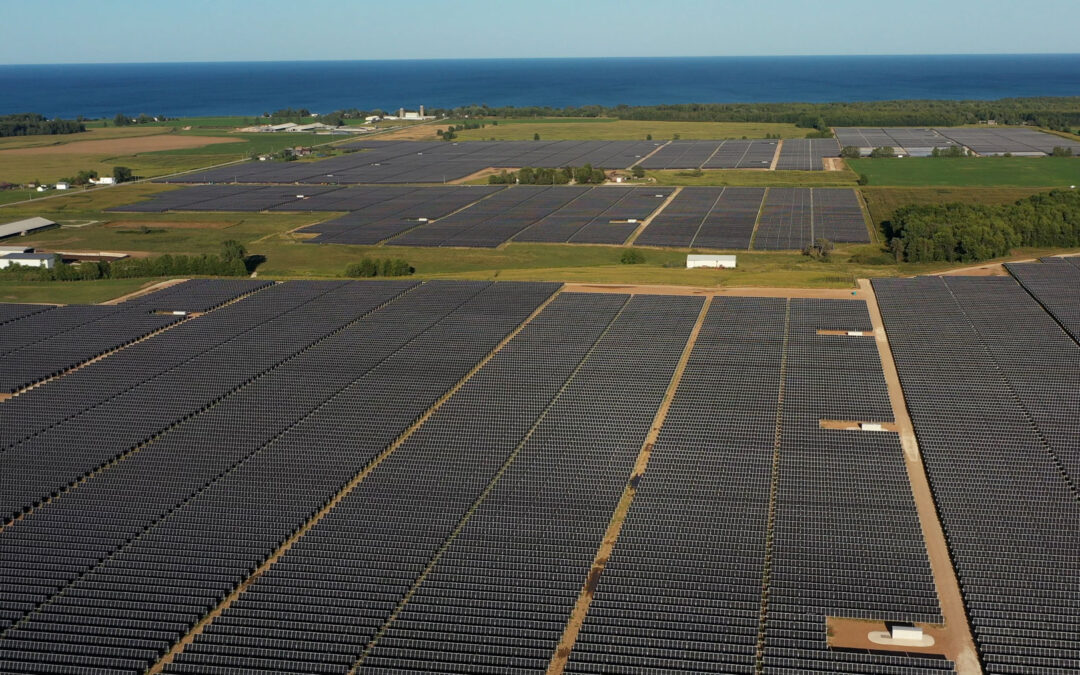
by Michael Vickerman | Nov 15, 2020 | Public Service Commission, Renewables, Solar, Utilities, Utility Scale
The Two Creeks Solar Park, located in Manitowoc County, was energized last week, becoming the state’s largest generating station powered by the sun. Developed by Florida-based NextEra Energy, Two Creeks is jointly owned by two Wisconsin electric utilities: Wisconsin Public Service Corporation (WPS) and Madison Gas and Electric (MGE). WPS owns and operates a 100 megawatt (MW) share of the 150 MW power plant, while MGE has the remaining 50 MW share.
Located next to the Point Beach Nuclear Plant, Two Creeks effectively doubles the amount of solar generating capacity in Wisconsin to 300 MW, and will, over the next six months, produce more electricity than the combined output from all other existing solar systems in Wisconsin. Expected to produce more than 300,000,000 megawatt-hours a year, Two Creeks will generate about one-half of one percent of the state’s overall supply of electricity, which is the equivalent of what 33,000 residences consume annually.
Along with the 300 MW Badger Hollow Solar Farm in Iowa County, Two Creeks received approval from the Public Service Commission (PSC) in April 2019. These two were the pioneering solar farm proposals that navigated through the PSC’s power plant siting process and won approval from the agency. At the same meeting, the PSC granted a joint request from WPS and MGE to acquire Two Creeks.
Since then, the PSC has given the green light to two more solar farms totaling 249 MW in capacity, including NextEra Energy’s 100 MW Point Beach Solar Farm next door to Two Creeks. Point Beach Solar is under construction and should be completed in the fall of 2021.
Construction work on Two Creeks commenced on August 2019, kicked off with a groundbreaking ceremony that drew Gov. Tony Evers and the two utility ceos. Governor Evers’ appearance came less than a week after he issued Executive Order 38, articulating a goal of “ensuring all electricity consumed within the State of Wisconsin is 100% carbon-free by 2050.”
Building Two Creeks was no small undertaking. It involved punching thousands of posts into the ground to support horizontal tracking systems spreading across 800 acres of relatively flat terrain. Mounted on these rotating poles are more than 500,000 panels that follow the sun as it crosses the sky going east to west. Between the first rays of sunlight and the last ones before sunset, these panels soak in the sunshine and convert it to electricity.
A plant like Two Creeks will begin displacing higher-cost power at the moment it is energized, and these savings will grow significantly over the course of its 30-to-50-year life. True, the utilities will need to recover the cost of building the solar farm, somewhere in the vicinity of $195 million. But the savings utilities expect to reap from avoided fossil fuel purchases and pollution control expenditures will more than outweigh their investment in a zero-carbon generation source. Seen in this light, large-scale solar is indisputably the most cost-effective supply option that an electric utility can pursue going forward.
The benefits from Two Creeks extend beyond ratepayer savings. Manitowoc County and the Town of Two Creeks, the jurisdictions hosting the solar farm, expect to reap a combined $600,000 in local aids each year while the project remains in service. That number grows to $18,000,000 over the course of 30 years, which is the projected minimum lifespan of Two Creeks.
Solar is a noncombustible energy resource that does not emit any gaseous emissions or particulates when converted to electricity. Deploying solar at the scale of Two Creeks will capture significant public health and air quality benefits by avoiding emissions that are associated with conventional fossil generation plants. In another PSC proceeding involving a 15O MW solar farm in eastern Wisconsin, the developer anticipates annual emissions reductions in the following categories of pollutants: (1) nitrogen oxide (NOx) emissions by 195,000 pounds; (2) methane (CH4) by 20,000 pounds; (3) nitrous oxide (N2O) by 5,000 pounds; and (4) carbon dioxide (CO2) by 405 million pounds.
Decarbonizing the state’s fleet of power plants is also a job creation strategy. The PSC estimates that somewhere between 200 and 300 jobs were created during the project’s construction window. It’s quite likely that many of the workers involved in the building of Two Creeks are now hard at work constructing the adjoining Point Beach solar farm.
In the annals of Wisconsin electric utility history, Two Creeks represents a noteworthy milestone, as the first solar farm to clear the PSC’s power plant review process and become a valuable addition to the state’s portfolio of power plants. And it took only 18+ months from the crossing of the regulatory finish line for Two Creeks to start sending power into the grid.
Two Creeks can also be viewed as the lead entry in a parade of large solar farms seeking to cross the same regulatory finish line and proceed to construction and completion. Looking out over the next 12 months, the PSC will review and make decisions on six solar farm applications totaling 1,150 MW (see table below).
| Project name |
Developer |
County |
Capacity
(in MW) |
Anticipated decision date |
| Paris |
Invenergy |
Kenosha |
200 |
11/2020 |
| Wood County |
Savion |
Wood |
150 |
12/2020 |
| Grant County |
NextEra Energy |
Grant |
200 |
4/2021 |
| Onion River |
Ranger Power |
Sheboygan |
150 |
5/2021 |
| Darien |
Invenergy |
Walworth/
Rock |
250 |
7/2021 |
| Apple River |
National Grid |
Polk |
100 |
9/2021 |
| Springfield |
National Grid |
Dodge |
100 |
9/2021 |
Within that same 12-month window, we expect two more PSC-approved solar farms—Badger Hollow I (150 MW) and Point Beach (100 MW) to cross the finish line and begin generating electricity.
What we’re seeing here is the emergence of a new resource paradigm that is ushering in a major wave of public works construction across the state. As this transition unfolds, solar power will become widely recognized as a linchpin in the state’s economy, extending through this decade and beyond.
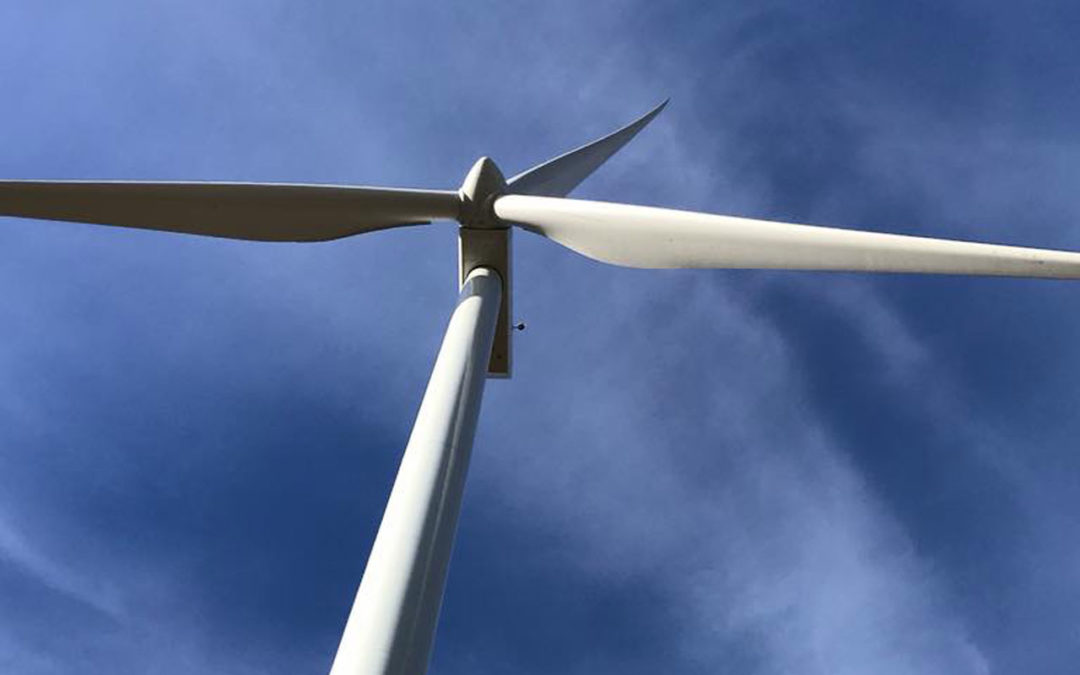
by Michael Vickerman | Jun 16, 2020 | Public Service Commission, Renewables, Utility Scale, Wind
In the first-ever test of the appeal process set forth in Wisconsin’s Wind Siting Rule (PSC 128), the Public Service Commission (PSC) reviewed and upheld Green County’s approval last fall of a 24-turbine, 65-megawatt (MW) wind project slated for development there. Following the county’s original decision, local wind farm opponents petitioned the PSC to invalidate the project’s permit, contending that the developer’s application was incomplete.
On June 11, the PSC denied the petition on a 3-0 vote, and in so doing removed the last remaining legal obstacle from the project’s path. As it stands today, the Sugar River wind farm is fully compliant with the standards set forth in the statewide rule relating to public health and safety, and may now proceed to construction.
Advanced by EDF Renewables, a nationally prominent renewable energy producer, Sugar River is capable of generating enough electricity to equal the consumption of 20,000 Wisconsin households. When operational, Sugar River will also yield about $260,000 in annual revenues, with nearly $152,000 going to Green County and more than $108,000 to the Town of Jefferson. Before ground can be broken, however, EDF will need to either sign a power purchase agreement with an off-taker or agree to sell the wind farm to an electric provider when construction is complete.
Sugar River was one of the first two wind energy proposals in 2019 to go through the local government review process specified in PSC 128. The other proposed wind farm, the 99 MW Red Barn project in Grant County, secured a conditional use permit in July 2019. No appeal of Grant County’s decision was filed. Like Sugar River, Red Barn is expecting to begin operation in the second half of 2021, assuming a partnership has been forged with an electric provider.
Sugar River provided the first significant test of PSC 128 after the rule narrowly survived a repeal vote during the 2011-2012 legislative session. The rule establishes a mechanism whereby a citizen group or a development company may challenge a local government decision on a proposed wind farm. Under this appeal process, the PSC’s role is to ascertain whether the local government adhered to all the standards and procedures in rendering a decision on a wind farm proposal.
In the case of Sugar River, the PSC agreed to take up the appeal filed by No Green County Wind in October 2019. Before rendering its decision, the PSC invited interested parties to submit comments on the matter. In its comments, RENEW expressed its support for the Sugar River project, as well as the regulatory framework that allowed the project to be given a fair hearing at every step of its permitting journey. The PSC plans to issue a written decision in July.
The approvals of Sugar River and Red Barn signal the end of a protracted lull in wind development activity lasting from 2011 to 2017. Between an adverse political environment and a glut of generating capacity, wind energy development stalled in Wisconsin. During the dry spell here, developers flocked to greener pastures in neighboring states. The door reopened slightly when Dairyland Power Cooperative agreed to purchase electricity generated from Quilt Block Wind Farm, which started operating in November 2017.
Though local opposition to wind development remains very much alive today, the experience with Sugar River attests to the strength and durability of Wisconsin’s Wind Siting Rule, which foretokens brighter days for the wind power industry here.
To learn more about the Sugar River Wind Farm, visit these previous blog posts.
PSC affirms local approval of Sugar River Wind Farm
Local Residents Discuss Wind Energy in Wisconsin
A Scientific Look into Wind Power and Human Health
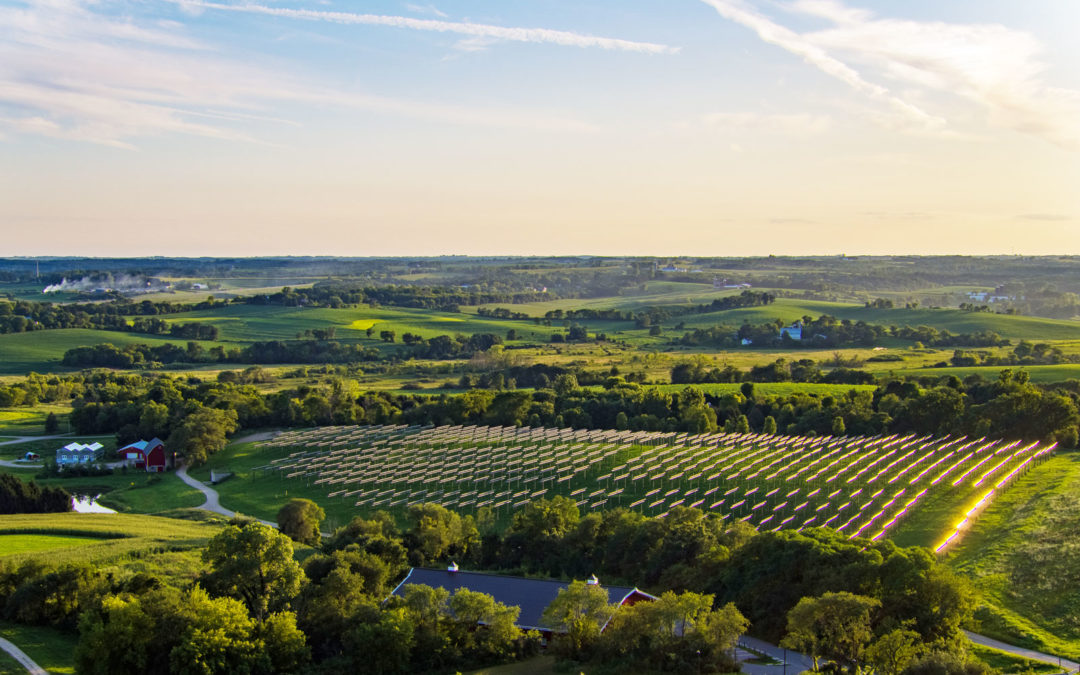
by Heather Allen | Apr 1, 2020 | Advocacy, Public Service Commission, Solar, Utility Scale
Amid our current health and economic challenges, the solar industry is committed to investing in local communities, creating jobs, and increasing tax revenues with clean, homegrown energy. Large scale solar projects are currently being built in Wisconsin and new projects are on the horizon, ready to contribute to Wisconsin’s energy mix! In order to ensure success, we need you to help a critical project win approval at the Public Service Commission.
The Paris Solar Energy Center is a 200 megawatt project proposed in Kenosha County, Wisconsin. The project will supply homegrown, affordable, emission-free electricity to 55,000 homes. If approved, the Paris Solar Energy Center would more than double the solar generating capacity we have operating in Wisconsin today. Paris Solar would begin producing clean power by 2022. Want to learn more? Check out the application here.
Help us demonstrate Wisconsin’s enthusiastic support for this project and renewable energy.
RENEW Wisconsin will share the list of supporters with the Public Service Commission during the official comment period for this project.
Please add your name to our petition!

by Michael Vickerman | Feb 20, 2020 | Public Service Commission, Renewables, Solar, Utilities, Utility Scale
The Public Service Commission today cleared the path for the Badger Hollow solar farm to become a utility-owned generating asset in its entirety. Approved in April 2019 and now under construction, the 300 megawatt (MW) plant in western Iowa County will soon be co-owned by a third utility, Milwaukee-based Wisconsin Electric Power Company (WEPCO). Chicago-based Invenergy is the developer for Badger Hollow and will oversee the construction process until its completion in 2021
As a result of today’s action, WEPCO and Madison Gas and Electric (MGE) will jointly acquire a 150 megawatt share of this facility, which should start sending power into the grid by the end of 2020. Shares of the 300 MW solar farm will be divided equally between WEPCO, MGE, and Green Bay-based Wisconsin Public Service.
After reviewing the applicants’ filings, the PSC determined that both MGE and WEPCO need new generating capacity in the near future, and that this 150 MW increment of Badger Hollow would be part of the least-cost expansion plan for both utilities.
RENEW submitted a letter of support for the acquisition, as did the cities of Milwaukee and Madison. Calling attention to the state’s clean energy goals as well as those of the two cities and the utilities that serve them, our comments emphasized the economic and environmental value that Badger Hollow will yield to utility customers as well as to project participants, host communities, and the state as a whole.
The PSC’s approval effectively brings the first chapter of utility-scale solar development in Wisconsin to a close. Since June 2018, the PSC has reviewed four proposals to build nearly 700 MW of in-state renewable generating capacity, and gave the green light to all of them. The following table summarizes these projects and their relationships to Wisconsin electricity providers.
| Project |
Capacity (in MW) |
Developer |
Utility participant(s) |
Location (by county) |
| Badger Hollow |
300 |
Invenergy |
WEPCO (100 MW)
MGE (100 MW)
WPS (100 MW) |
Iowa |
| Two Creeks |
150 |
NextEra Energy |
WPS (100 MW)
MGE (50 MW |
Manitowoc |
| Point Beach |
100 |
NextEra Energy |
WPPI Energy |
Manitowoc |
| Badger State Solar |
149 |
Ranger Power |
Dairyland Power Cooperative |
Jefferson |
The next wave of solar farms will begin washing through the state regulatory review process this spring. The first one out of the gate is the Paris Solar Farm, located in Kenosha County. Invenergy’s application to build the 200 MW solar farm was submitted yesterday. Dockets have been opened for several other prospects in Wisconsin. Listed below are the solar farm projects that we anticipate will be reviewed by the PSC this year.
| Project |
Capacity (in MW) |
Developer |
Location (by county) |
Docket number |
| Paris |
200 |
Invenergy |
Kenosha |
9801-CE-100 |
| Grant County |
200 |
NextEra Energy |
Grant |
9804-CE-100 |
| Wood County |
150 |
Savion Energy |
Wood |
9803-CE-100 |





